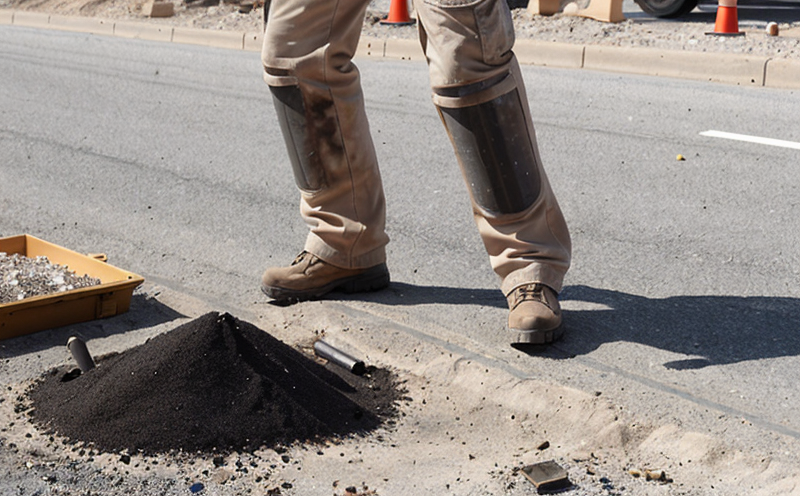ISO 22390 Blasting Materials Safety Evaluation Testing
The ISO 22390 standard is specifically designed to ensure the safety of blasting materials used in various industries, including mining and construction. This testing ensures that these materials meet strict safety criteria before they are used on-site. Compliance with this standard is essential for ensuring worker safety and regulatory compliance.
The process involves several steps, starting with the selection of appropriate test samples. These samples are then subjected to a series of tests designed to evaluate their mechanical properties, thermal stability, and detonation characteristics under various conditions. The testing environment must be controlled to ensure accurate results. For instance, temperature, humidity, and other environmental factors can significantly impact the performance of blasting materials.
The ISO 22390 standard specifies that testing should follow a step-by-step procedure, starting with initial material characterization, followed by mechanical property tests such as tensile strength, compressive strength, and shear strength. Thermal stability is assessed through thermal decomposition studies at specified temperatures. Detonation characteristics are evaluated using high-speed cameras to capture the initiation and propagation of detonation waves.
The results from these tests are crucial for understanding how the blasting materials will behave in real-world scenarios. For example, the mechanical properties determine the material's ability to withstand stress without failure during blasting operations. Thermal stability is critical to prevent unintended premature detonations that could cause accidents or property damage. Detonation characteristics ensure that the materials can be safely handled and stored.
In addition to these basic tests, ISO 22390 also includes more specialized tests for specific applications. For instance, in mining operations, the standard may require testing for resistance to shock waves, which is crucial for deep-hole blasting. In construction, tests for water resistance are important, especially when working near bodies of water.
The importance of this testing cannot be overstated. By adhering to ISO 22390, industries can ensure that their blasting materials are safe and reliable. This not only protects workers from potential injuries but also helps prevent environmental damage. Regulatory bodies worldwide recognize the importance of this standard, ensuring consistent quality across different regions.
In conclusion, ISO 22390 Blasting Materials Safety Evaluation Testing is a critical component of any safety management plan in industries that use explosives and blasting materials. It provides a structured approach to evaluating these materials' safety properties, offering peace of mind for both operators and regulatory authorities.
Scope and Methodology
| Test Parameter | Description |
|---|---|
| Material Characterization | Involves initial analysis of the blasting material's composition and physical properties. |
| Mechanical Property Tests | Includes tensile strength, compressive strength, shear strength tests to evaluate resistance under stress. |
| Thermal Stability Studies | Determines the temperature at which blasting materials begin to decompose and release harmful gases. |
| Detonation Characteristics | Evaluates how quickly and completely the material can be detonated safely. |
| Shock Wave Resistance (Mining) | Tests for resistance to shock waves, especially important in deep-hole blasting. |
| Water Resistance (Construction) | Evaluates the material's ability to withstand water exposure without degradation. |
Industry Applications
The ISO 22390 standard is widely applicable across various industries, including mining and construction. In the mining sector, this testing ensures that blasting materials can withstand the harsh underground environment and the demands of deep-hole drilling.
In the construction industry, ISO 22390 plays a crucial role in ensuring safety during excavation projects. The standard helps ensure that workers are not exposed to unsafe conditions due to unstable or hazardous materials being used for blasting operations.
The testing process is particularly important when selecting materials for large-scale projects where the risk of accidents and environmental damage is high. By adhering to ISO 22390, industries can reduce these risks significantly, leading to safer work environments and more reliable project outcomes.
For mining operations, compliance with this standard ensures that blasting materials are suitable for use in confined spaces where there is a higher risk of accidents. In construction, the standard helps ensure that workers are safe from potential explosions or other hazards associated with improper material selection.
International Acceptance and Recognition
The ISO 22390 standard is widely recognized and accepted across the globe. It has been adopted by numerous countries to ensure consistent safety standards for blasting materials. This global recognition highlights the importance of this testing in maintaining high safety standards worldwide.
Many regulatory bodies, including OSHA (Occupational Safety and Health Administration) in the United States, have incorporated ISO 22390 into their guidelines for explosives management. Similarly, international organizations such as the International Labour Organization (ILO) recommend adherence to this standard for ensuring worker safety.
The acceptance of ISO 22390 extends beyond just regulatory bodies; it is also widely accepted by insurance companies and other stakeholders in the industry. Adherence to this standard can significantly reduce the risk of claims due to accidents or property damage, making it a valuable tool for risk management.





